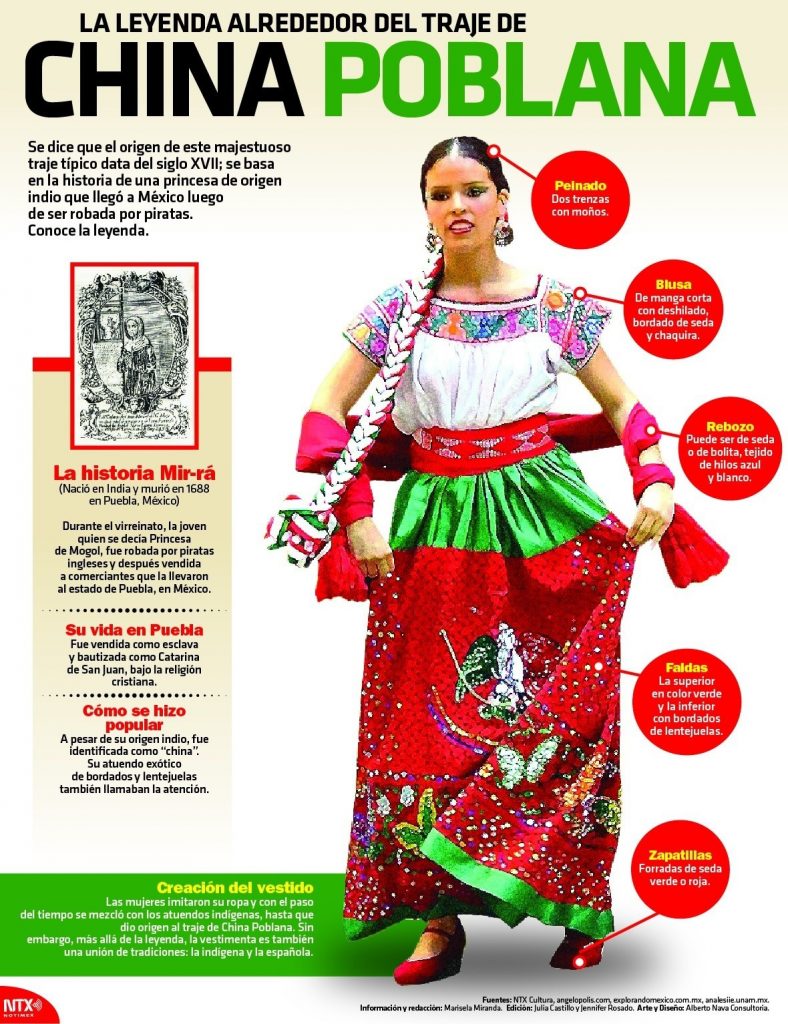China Poblana: A Dress Where East Meets West in a Mexican Fiesta

©️ Public Domani Published by the United Nations
Do you think you have seen it all when it comes to dresses? Think again!
The China Poblana is like a fiesta for your eyes, a party on a skirt, and a guaranteed conversation starter (especially if you accidentally call it a ‘Chinese woman dress’). Buckle up for a wild ride through the history of this flamboyant Mexican masterpiece!

It All Comes From Catarina de San Juan
The most popular origin story of the China Poblana centers around Catarina de San Juan, an Indian princess. Tales claim pirates kidnapped her, sold them into slavery in Manila, and eventually ended up in Puebla, Mexico.
There, her unique Asian attire, possibly a sari, captivated the locals. Women began to incorporate elements of her clothing into their wardrobes, sparking a trend that would define Mexican fashion for centuries.

Historical Doubts and a Fashionable Evolution
While this story holds romantic appeal, historians find it unlikely to be entirely accurate. There’s a lack of concrete evidence to support Catarina’s existence. The China Poblana’s design likely emerged from a confluence of influences.
Women in 19th-century Mexico wore clothing reflecting European styles, often with Spanish influences like the “maja” dress, and indigenous traditions. The “China look,” characterized by vibrant colors and rich embroidery, may have been inspired by a general fascination with Asia at the time.
Trade routes brought Asian textiles and designs to Mexican shores, sparking a desire to incorporate these elements into local attire.

From Sari to Skirt: A Transformation
Regardless of its exact origins, the China Poblana’s design undeniably evolved from garments like the sari. Catarina de San Juan, true or not, may have played a role in popularizing a style that incorporated elements of her Asian heritage. The final product became a distinctive Mexican creation:
- A Short-Sleeved White Blouse: Adorned with intricate floral or geometric embroidery in vibrant colors, often silk or cotton thread.
- A Flowing Skirt: Made from a ” castor fabric,” possibly named after the beaver fur it originally mimicked. Sequins and “camarones” (literally, shrimp) shapes were sewn onto the skirt, creating eye-catching patterns.
- A White, Lace-Trimmed Slip: The “enchilada stitching” with its zig-zag lacework peeked out from under the skirt, adding a touch of elegance and revealing the woman’s form in a way that scandalized some in 19th-century society.
- A Shawl: Woven from fine silk or more commonly with bobbles, it served a practical purpose – keeping women warm and providing a way to carry items. The Otomí people in San Luis Potosí were especially known for their blue and white bobble shawls, a signature element of the China Poblana.

China Poblana Is A Symbol of National Identity
The China Poblana’s popularity soared in the 19th century. It became a national symbol of Mexican femininity, often associated with the “china” archetype – a woman known for her beauty, spirit, and perhaps a touch of rebellion against societal norms.
The vibrant dress-adorned dancers perform the “fandango,” a popular Mexican dance. It graced women of all social classes, a testament to its versatility and adaptability.

Beyond the Glitter: A Legacy of Cultural Exchange
The story of the China Poblana is a testament to the dynamic nature of fashion. Cultures borrow, adapt, and reinterpret, creating something entirely new.
The China Poblana stands as a vibrant reminder of this ongoing exchange. It’s a dazzling symbol where East meets West in a beautiful Mexican embrace.
China Poblana is Beyond Fashion
The China Poblana is more than just a beautiful dress. It’s a reminder of Mexico’s rich history, steeped in cultural exchange and openness to global influences. It’s a testament to the enduring power of fashion to tell stories, capture imaginations, and celebrate cultural diversity.
The next time you see the China Poblana, step beyond the vibrant colors and intricate details. See it as a window into Mexico’s fascinating past, a symbol of national identity, and a testament to the enduring power of cultural exchange.
You might also like to read: The Mother Who Hunted Down Her Daughter’s Killers


